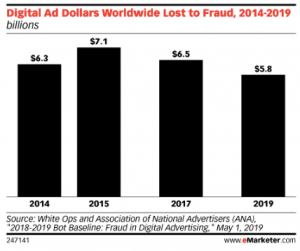Ten years ago, I debuted as the CEO of an ad server. At that time, my Epom team broke into the AdTech industry with a technology that allowed advertisers, publishers, and ad networks to make revenue with online ads.
Lots of things have changed since then. I still remember the early 2010s as the heydey of ad networks, affiliate agencies, and delayed analytics. I was lucky to witness the rise of native ads and the birth of the first demand-side platforms. Then the ubiquitous obsession with app monetization arose. AdTech was flooded by companies chasing for crystal clear traffic from mobile apps. Remember those days?
New ad formats were debuting nearly weekly, and companies were in competition for both originality and customers. This is not to mention the fact that Programmatic technology has been picking up the pace since 2009 without a break.
If you work in AdTech, you know that this industry has been always afoot. ALWAYS. It’s one of the most dynamic and challenging industries. This is why in AdTech you have to always keep a finger on the pulse, make decisions immediately, and rethink your business strategy over and over again. You should be ready for ups and downs, ups and downs.
Read More: How Brands Can Stay Relevant With Agile Branding
Ten years after my first day as CEO in AdTech, it’s hard for me to look back. I’m more excited to see what’s happening in the industry today and where online advertising is headed to next.
Programmatic Keeps up the Pace
The glory days of ad networks and affiliate agencies remained in the past, which made way for programmatic. Today, the flames of programmatic are all across the industry. Programmatic is an automated technology for buying and selling ad impressions in real-time. It brought media buying to a new level of automation, targeting, and transparency.
By the end of this year, programmatic is expected to rake in $84.9 billion from advertisers (Zenith), which is equal to 65% of all global digital ad spendings. Every year programmatic ad sales demonstrate around 21% growth. For a technology that debuted more than 10 years ago, these numbers are quite impressive. Agreed?
My most tangible explanation of this fact lies in its ongoing simplification and affordability. These days anyone can sign up for a self-serve DSP and start advertising products across millions of screens. Whether you run a million-dollar business or a startup, you can get an account and hit a precisely targeted audience with ads. Depending on the budget, you have two main options, outsource your Digital Advertising or keep it in your office.
In-House Programmatic and Own DSPs
Today, many brands prefer to delegate programmatic media buying to their teams instead of outsourcing. I believe that this recent tendency to programmatic in-housing will be spread globally. The IAB report states that 65% of marketers bring all (18%) or part (47%) of programmatic media buying activities in-house. In-housing means that the company integrates programmatic into its media strategy, maintains traffic purchases, controls ad performance, and optimizes it on their own.
Some even jump to the next level by building their own DSPs. With plenty of white-label DSP solutions available, advertisers don’t need to spend millions of dollars on technology development anymore. All they have to do is to hire a ready-to-use DSP technology, customize it, and use it as their own.
What makes advertisers create their own DSPs to advertise online? The main reason is the absence of middlemen between brands and their audience. Also, having your own demand-side platform frees you from paying fees to other DSPs.
Previously, Epom’s white-label DSP solution was mostly hired by ad networks and ad agencies. While today, near-50% of all our users are represented by brands, app developers, game developers, and solo entrepreneurs.
Advertisers Chase for Transparency
The lack of transparency is yet another reason to make businesses think about advertising with their own DSPs. Unfortunately, even today, ad fraud remains one of the most critical issues (and budget eaters) for brands.
The good news is that year after year the situation is improving. After analyzing 27 billion ad impressions, the researchers from White Ops and Association of National Advertisers leaped to the conclusion that ad fraud will probably lose $5.8 billion by the end of 2019.
 Source: eMarketer
Source: eMarketer
AdTech companies are joining forces to kick out fraudsters and other performance-related manipulations from the industry. The number of new anti-fraud solutions is increasing, and programmatic platforms continue hiring them to ensure brand safety.
In recent years, demand-side platforms also managed to put effort into creating a world with zero-fraud. In whole or in part, DSPs have started to reveal their supply partners. Media Buyers benefited from this a lot. The disclosure of publishers let them identify the best-performing traffic sources, and exclude those with low-performance rates. Now guess who suffered the most substantial damage? Obviously, the fraudsters.
Read More: The Blurring Lines Between B2B and B2C
First-Party Data Remains Essential
This is not a surprise that the first-party data drives the highest value for advertisers. The 2018 survey conducted by Sizmek discovered that 85% of marketers in the US and Western Europe consider the use of first-party data their critical priority. It’s hard to escape the conclusion that AdTech will proceed with purchasing user information from DMPs to ensure precise targeting.
Another thing that could probably happen in 2020 is extensive neglecting of third-party cookies among ad platforms. Browsers offer many options on how to block cookies, and this creates new challenges for the industry. I believe that in 2020 will bring new safe ways of user identification outside third-party cookies.
There are too many businesses that are struggling for the user’s attention. To not lose this fierce competition, brands have to be very picky towards visuals, precise towards targeting, and clear towards their key message. Nowadays advertisers place importance on the quality of creatives and behavior analysis more than ever before.
The Supply-Side Acquires Demand-Side
Even though the number of AdTech companies goes up every year, the market is mostly divided among older players. Not mentioning Facebook, Google, or Amazon, leading ad marketplaces like MediaMath, theTradeDesk, and Adobe DSP hold their positions high.
Young AdTech companies have to not only try hard to earn their market share, but they should also be different. At the latest DMEXCO, I discovered at least ten new platforms for advertisers that allow placing ads into VR games and Voice speakers. Unlike the old-timers with their ‘cross-screens’ and ‘all-in-all’ approach, newcomers prefer to be more specific and stay niche.
By recently, AppNexus and DataXu also were among the industry leaders, but what happened to them points out to another interesting industry change. Two powerful ad marketplaces were fully acquired by supply sides.
In 2018, the AT&T company acquired AppNexus. Through its broadcasting business, AT&T had over 170M direct relationships with customers. Purchasing a large demand partner with thousands of advertisers connected allowed AT&T to put all their customer data at work. Now advertisers can sleep well, knowing that their ads are shown directly to their targeted audience jumping over any middlemen.
A few weeks ago, a streaming company Roku bought dataxu DSP for $150M. After adding dataxu, Roku will be able to deliver data-driven ads to over 30.5 million of its active users through streaming players and TVs. The streaming company will also help their publishing partners better monetize their traffic.
Will this tendency to absorbing spread? We don’t have many reasons to assume the opposite.
Instead of Conclusions
Ten years in AdTech helped me clearly understand one thing: in this industry, tomorrow is never the same as today. To gain long-term success in AdTech, you have to play fair, don’t be afraid of experiments, and never stop trying. Let’s stay tuned and keep rolling!
Read More: Achieving MarTech and AdTech Success – Digital Agencies Need the Right It Infrastructure











